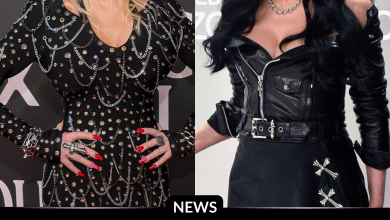Auctioned for Millions: What Marilyn Monroe’s Maternity Dress Reveals About Her Final Pregnancy
OPINION: This article may contain commentary which reflects the author's opinion.
Marilyn Monroe’s legacy is steeped in glamour, tragedy, and the timeless allure that made her an icon. Yet, beyond the glimmering Hollywood persona lay a deeply personal narrative, one that remains subtly woven into the fabric of her life—quite literally. One of the more understated pieces of Marilyn’s story is embodied in a simple red maternity dress, worn during her last pregnancy in 1958 while she filmed the classic Some Like It Hot. This unassuming garment has since taken on profound significance, offering a window into the struggles she faced behind the camera.
A Personal Artifact of Motherhood
The dress itself is a red cotton, button-down design, featuring long sleeves, pockets, and a whimsical rooster and chicken pattern. It wasn’t a gown meant for the red carpet, nor a costume crafted to enhance her on-screen persona. Instead, it was a practical piece, reflective of a woman trying to navigate the delicate balance of professional obligations and personal hope.
Captured in photographs taken by Janice Sargent, Monroe’s figure is modestly concealed, with her hands often resting over her midsection. These images suggest she was around two to three months pregnant at the time. The maternity dress thus stands not only as a sartorial choice but as a testament to a period of hope and anticipation. For Monroe, it was a symbol of the private dream of motherhood, a dream that, tragically, would not be realized.
The Pregnancy and Its Challenges
In late October 1958, Monroe and her then-husband Arthur Miller discovered she was pregnant. The timing overlapped with the tail end of shooting Some Like It Hot. By this point, her most demanding scenes had already been filmed. However, the production itself had been far from smooth. Billy Wilder, the film’s director, recounted the pressures of working with Monroe, describing the schedule delays, her frequent tardiness, and the palpable tension on set. Monroe’s use of pills, including the barbiturate Amytal, added another layer of concern. The production ultimately wrapped on November 6, 1958, though the atmosphere left cast and crew strained.
After the filming concluded, Monroe returned to New York, intent on resting during the early stages of her pregnancy. However, the pressures of her life—combined with the medications she relied on—took their toll. By mid-December, Monroe suffered a miscarriage. It would be her last known attempt at motherhood. The event left her grief-stricken and guilt-ridden, as she later expressed in letters, questioning whether her medication or choices might have contributed to the loss.
An Auction and Uncertain Whereabouts
The maternity dress, along with many other personal items, was part of Christie’s 1999 auction, “The Personal Property of Marilyn Monroe.” The event, often called “The Sale of the Century,” drew international attention, bringing in over $13 million. Iconic pieces like her “Happy Birthday” dress captured headlines, but the maternity dress quietly changed hands without fanfare. Though sold, the exact price and buyer remain unknown. Today, the dress’s whereabouts are not widely publicized, leaving its current status a mystery.
A Reflection of Quiet Struggles
While Monroe’s life was often on public display, this maternity dress tells a quieter, more poignant story. It reflects a woman trying to hold onto a personal dream while bearing the weight of her career and the intense scrutiny that came with it. Unlike the glamorous costumes immortalized on screen, this garment reminds us of the deeply human moments in Monroe’s life—the hopes, the hardships, and the heartache.
In the end, this simple red dress is more than just fabric. It’s a chapter in a life that, for all its dazzling heights, was not without its profound struggles. For fans and historians alike, it offers a chance to see Marilyn Monroe not just as an icon, but as a person—resilient, vulnerable, and deeply human.



